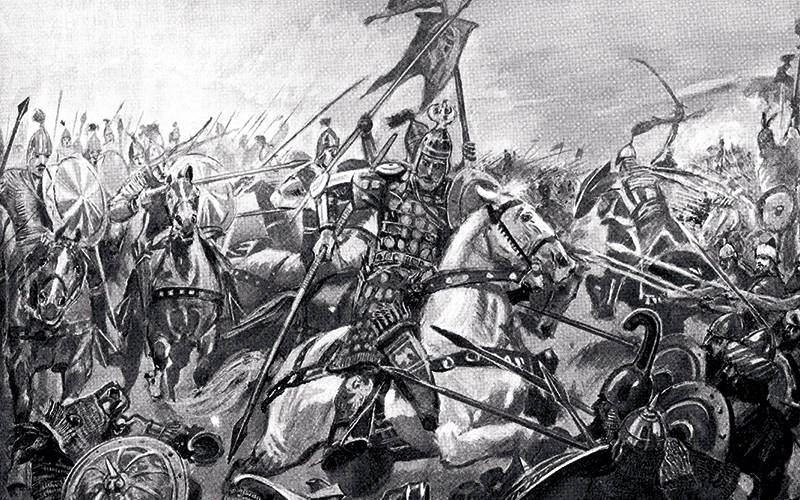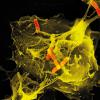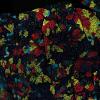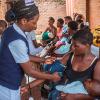Stephen Mortlock delves into military medicine in the ancient and medieval world.

Sun Tzu (544–496 BC), the Chinese general, strategist, philosopher and writer, believed “the greatest victory is that which requires no battle”. Unfortunately, since the beginning of time, early settlements have had to protect themselves from external aggressors who wanted food, valuables or slaves. Whatever fighting occurred was probably conducted by informally organised groups, which themselves would have been limited by the supplies available and a lack of reason to fight beyond their immediate needs. Records show that the citizens of the Greek ancient city-states were not only farmers or athletes but were also expected to defend the city-state from its enemies. They needed to participate in battles, with the defensive and offensive weaponry at that time. The weapons were probably made from wood, stone or bone and may have started life as farm implements. These developed into weapons such as the spear, the bow and the sling, polearms (close-quarter weapons) such as the falx (curved sword) and javelin, or hand-to-hand weapons such as swords, clubs, maces, axes, and knives. The treatment of wounds and fractures must have been given to casualties from the earliest periods of human history; in Roman times this was initially limited to self-care and buddy aid or by civilian assistance from family members. Much of the Roman professional knowledge came from Greek prisoners of war adept in medicine and they allowed them to carry on their research and subsequently adopted many of their ideas. The Greeks fought with their neighbouring city-states but also went to war with and for other powers, so their military medicine spread through much of the ancient world. But it was the Assyrians who were the first to provide dedicated surgeons to their armies. Unfortunately, the library of King Assurbanipal, which contained numerous medical texts, was destroyed during the Battle of Nineveh. The texts were lost forever and the role of military surgeon disappeared. Late in Hellenic history, however, Philip of Macedon and his son Alexander began taking military surgeons on their campaigns again and elevated those practitioners to a status they would not enjoy again for centuries.
The Egyptians and Greeks
Physicians travelled with the Egyptian military on war campaigns in order to treat the wounded, usually under the auspices of the Pharaoh. The Egyptians were masters in applying and arranging bandages, and they recognised the cardinal signs of infection and inflammation. The oldest medical textbooks in existence (the Ebers Papyrus, and Edwin Smith Papyrus, both from around 1550 BC) were devoted to wound care. They describe cases of injuries, fractures, wounds, dislocations and tumours. Simple wounds received an application of fresh meat, sealed with a mixture of oil and honey and wrapped in a linen bandage. As an ancient wound dressing, honey would have been ideal as it would not grow bacteria. More severe wounds that gaped but were uninfected were sewn with plant materials, such as hemp, or cotton, or animal material, such as tendons, silk, and arteries. The material of choice for many centuries was catgut – a fine thread woven from sheep intestines. Finally, if a wound became locally inflamed, desiccating solutions were applied to dry it out. If the patient developed sepsis, the wound was cauterised, effectively removing the damaged tissue to allow healing to occur. By at least 1600 BC, and probably much earlier, the ancient Egyptians were completely familiar with the various stages and severities of wounds and cared for them competently with the available tools. There is a documented account of yeast being used as an antibiotic, with the “yeast of sweet beer” being used on wounds. And that crust of mouldy bread we tend to throw away, the Ebers Papyrus states could be used for a multitude of remedies. The medicine of ancient Egypt was made from a vast array of plants and other materials that are now recognised as having pharmaceutical properties. For example, raw garlic was used extensively due to its allicin content and is known to have antibacterial and antiparasitic properties. A willow (Salix alba) and myrtle (Myrtus communis) concoction was used to ease inflammation and joint pains (both plants contain phenolic acids, tannins, flavonoids, glycosides, and terpenes). This was an early precursor to the use of salicin as it is used today in aspirin. The essential oils from Abies cilicica (the Cilician fir) were used as antiseptics while Frankincense (Boswellia sacra) could be used to stop bleeding and promote wound healing Other plants and minerals used include chickpeas, clover, cannabis, endive, iris, mustard, rose, rosemary, thistle, asparagus, eggs, liver, hair, wax, cumin, fennel, aloe, castor oil, and, rather disturbingly, faeces.
Hippocrates, the Greek physician and surgeon, (460–377 BC), known as the father of medicine, used vinegar to irrigate open wounds and wrapped dressings around wounds to prevent further injury. He washed ulcers with wine and after having softened them with oil, dressed them with fig leaves. Homer’s descriptions of wounds and treatments are similar where the wounds were first cleansed, washed with tepid water, treated with palliative and antiseptic herbs, and finally bandaged. The medicines used were, unsurprisingly, herbs to relieve pain and other symptoms of wounds. Wines and certain infusions were also used to help the healing process. Many of the detailed accounts of medical techniques can be found in the Iliad and the Odyssey and serve as the earliest source of information about Greek medicine. It is said that Helen of Troy, the cause of the war between the Achaeans and the Trojans, knew of an effective soothing herb that alleviated pain and anger and brought forgetfulness of every sorrow when mixed with wine. It should be remembered, however, that both of these epics were written several centuries after the Trojan War itself, so Homer was not talking about current medical practice but from an earlier era, however, many of the medicinal plants remained in use. The marshmallow (Althaea officinalis) is cultivated in many countries, and ancient Greek physicians used to add the root to grape must and, after a period of fermentation, administered the resulting wine for the healing of wounds and abscesses. While poultices made from it aid in recovery from burns and wounds, the efficacy of these uses are supported by our present understanding of the plant.
Diocles of Carystus (375–295 BC) was a well-regarded Greek physician and it is believed he designed the first practical solution for extracting arrows from the human body without causing extra damage – the spoon of Diocles. Contemporary accounts suggest this was used to remove the injured eye of Philip II without further disfiguring him. Following removal of the iron arrow, Sideritis commonly known as “Tsai tou Vounou”, a genus of flowering plants that in ancient Greece was used to heal the wound. The plant was also used to treat sword cuts (Sideritis is derived from Sideron, meaning “iron”).
Romans
The Roman army had one of the best win-loss ratios in history. For over a thousand years, the Roman legionaries and their auxiliary forces dominated the European, African, and Asian battlefields. Apart from the obvious battlefield injuries, thousands of soldiers were exposed to communicable and tropical diseases on overseas campaigns. Emperor Augustus implemented a number of reforms as he identified the importance of health to cut down losses and to raise troop morale during long military campaigns. As a result the Roman military medical system surpassed those of most of their enemies in treating and returning to duty many sick and wounded soldiers as rapidly as possible. The medical staff also played a key role in the recruitment process and evaluated the health of the candidates prior to them starting training. There were always enough recruits for the army since being a soldier meant a good salary, a better diet and medical services, and a pension. And for non-citizens, if they survived, their reward was Roman citizenship at the end of their service.
Honey is cleansing, opens pores, and draws out fluids. Boiled and applied it heals flesh that stands separated”
The Romans were the first army in history to employ medical corpsmen, the “milites medici” or “capsarii”, so-called after the capsa or box for bandages that they carried and, like modern-day counter-parts, legionaries also carried their own field dressings. Most Roman surgeons had practical experience on the battlefield and they carried a toolkit, which contained arrow extractors, catheters, scalpels, and forceps. They used to sterilise their equipment in boiling water before using it. Pedanius Dioscorides (40–90 AD) was a Greek botanist, pharmacologist, and physician who practised in Rome when Nero was the ruler. He became a famous Roman army doctor and wrote the five-volume pharmacopeia De Materia Medica, which listed over 600 herbal cures. He wrote that “honey is cleansing, opens pores, and draws out fluids. Boiled and applied it heals flesh that stands separated” and today we are still seeing the beneficial properties of honey. Plants like yarrow (Achillea millefolium) could be used an as anti-inflammatory while garlic is known to have antibacterial and antiparasitic properties. The leaves of the Uva Ursi (Arctostaphylos uva-ursi) plant are very rich in tannins and could be used to treat wounds to stop bleeding. The Romans performed surgical procedures using opium from the poppy (Papaver somniferum and P. rhoeas) and scopolamine to relieve pain and acid vinegar to clean up wounds. Flesh wounds received on the battlefield would be stitched with a needle and thread and if this was a deep wound, the “fibulae technique” was used where copper-alloy skewers were incorporated into the stitches to prevent “any bad humour collecting within”. They did not have effective anaesthetics for complicated surgical procedures, but it is unlikely that they operated deep inside the body. They also set up field hospitals close to the front lines to care for the wounded. The Roman efficacy in combat medicine may be one of the least appreciated aspects of the ability of the Roman army to help create and maintain an empire.
“The standard of military medicine struck a low level during the Middle Ages”
Medieval
Traces of Roman military influence still lingered on under Anglo Saxon and Norman rule but the standard of military medicine struck a low level during the ensuing centuries of the Middle Ages. Physicians, however, who accompanied the soldiers fighting in the Crusades (1096–1272) were required to follow the licensing laws for doctors in the states set up by the crusaders after the First Crusade. If they practised poor-quality medicine they were subjected to the medical negligence legislation in place there. Laws in the Kingdom of Jerusalem dating from the 1240s stated that a doctor who left a patient disabled if they applied poor plasters or splints, so that a fractured limb did not heal straight for example, was guilty of negligence. If the patient were a slave, the doctor would have to pay the owner the decrease in the slave’s value. If the patient were a free man, the doctor would be expelled from that city and have their thumb cut off so they could not practise surgery again. If a free man died as a result of negligent treatment, the doctor would be hanged (harsh but fair!). The Crusades did, however, give rise to religious orders such as the Knights Hospitaller and the Teutonic Knights, which did valiant work both in the Holy Land and upon returning home would later exert great influence upon the establishment of hospitals in Europe.
In the Summer of 1415, Henry V of England sailed for France, initially capturing the fortress town of Harfleur and continuing his march across the countryside towards Calais. On 25 October, in a muddy field near the village of Agincourt, a French army intercepted his route. Despite his men being exhausted, outnumbered and malnourished, Henry led his men into battle, the English archers decisively defeating the French, who suffered severe losses. Keeping an eye on the health of the army were Sir Thomas Morstede, William Bradwardyn and Nichol Colnet, physicians to the king. Prior to the campaign, Sir Thomas Morstede had applied to the Chancellor of England for money to “purchase medical stores (unspecified) as well as one cart and two horses to carry the stores and twelve persons of my craft such as I should choose to accompany me and serve your most sovereign lord during your campaign.” Deaths and casualties during the campaign from military action were comparatively low (contemporary figures suggest there were 400–600 English casualties at Agincourt); sickness, however, was very high. Records show that 2000 people died from the “flux” or “cours de ventre” and 5000 more had to be invalided home. The disease ran an acute course, often being fatal in a few days. The sickness was almost certainly dysentery with a severe diarrhoea and passage of blood, caused by the unhygienic conditions. Treatment was varied but seemed to be a combination of herbal and spiritual (Psalm 56 to be recited three times). Opium and bramble roots (Rubus fruticosus) were the main remedies with the tannin in the leaves and bark of the bramble acting as an astringent to treat the dysentery and diarrhoea. Wounds would be sealed with egg whites; when dry they provide a natural protective barrier. Egg whites contain conalbumin, a glycoprotein that binds to iron and inhibits bacterial growth. Alcohol or plants like mandragora (Mandragora officinarum) would be used to send people to sleep. Mandragora root contains hyoscine, a powerful alkaloid with the ability to cause hallucinations, delirium and, in larger doses, coma. Some believe St John’s wort (Hypericum perforatum) takes its name from the knights of St John of Jerusalem who used it as a wound herb on the crusade battlefields. Although a traditional wound herb and painkiller, its usefulness in reducing inflammation is well known, and appears to be related, at least in part, to its ability to serve as an antibacterial agent. Honey, just as in ancient times, was a crucial element in medieval military medicine, particularly for the treatment of wounds, and appears to have been kept on hand in the stores of a number of castle garrisons even when other foodstuffs were depleted or sold. There are Exchequer accounts in the British National Archives detailing the provisioning of late medieval castles and one curious detail is that it categorises the need to maintain supplies of honey in castle stores. During the reign of Edward II, Hugh Despenser the Younger (hanged as a common criminal in 1326 for murder, piracy and extortion among other things), acting as keeper for the castle and town of Bristol, oversaw the sale of castle provisions but ensured that the store of honey was not included in the sale. The pharmacopeias of the day also contained ingredients compounded from the parts of different animals. Field medical chests of the period included oils of vipers and angleworms, beetles and earwigs, among others.
Diocles of Carystus was a well-regarded Greek physician. It is believed he designed the first solution for extracting arrows
Conclusions
How do you measure civilisation? Is it the development of agriculture to produce food, the wheel, a system of government or the introduction of writing? Margaret Mead (1901–1978) the American cultural anthropologist believed that the first sign of civilisation was a 15,000- year-old fractured femur that had healed. It was evidence that someone had taken time to stay with the injured person, bound up the wound, carried them to safety and had tended them through their recovery. It is impossible to know if the fracture was accidental or due to some conflict but the fact that someone cared for the injured person is significant. In the past, doctors, often quite unskilled in their art, used wound treatments that had been discovered by ancient peoples such as honey, sap, and other plant extracts, which had been shown to have useful pharmacological properties. Kings and lords of the manor often recruited these doctors for temporary military service during their campaigns, but the provision of hospitals for troops was virtually non-existent after the Romans. The Church, although able to provide medicines and beds for the sick, was often incapable of coping with large numbers of military casualties and so a dedicated service was developed, from the Roman capsarii to the ambulances of Dominique Jean Larrey during the Napoleonic wars. But, today wherever there is conflict there are personnel looking after the wounded. The Geneva Conventions of 1949 require personnel to comply with the “principles and spirit” of the conventions not to distinguish between the wounded other than on medical grounds and to ensure “all possible measures shall be taken at all times to collect the wounded, sick, and shipwrecked and to ensure their adequate medical assistance.”
The author would like to thank Marcial Navarro and the microbiology team at Frimley Park Hospital for their continued support and training over this last year.
Image credit | Alamy | Shutterstock | iStock




